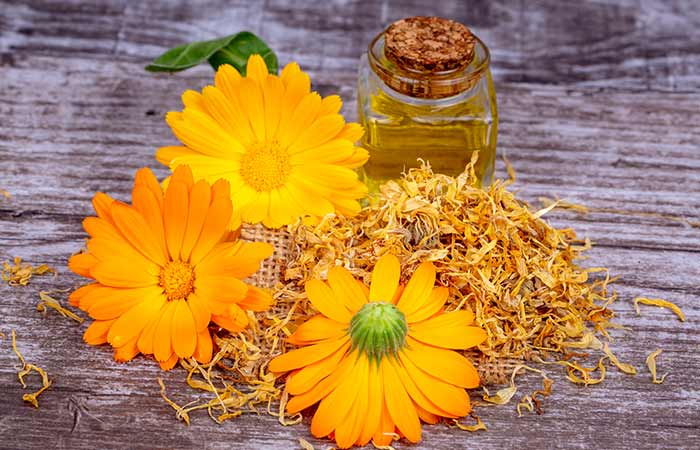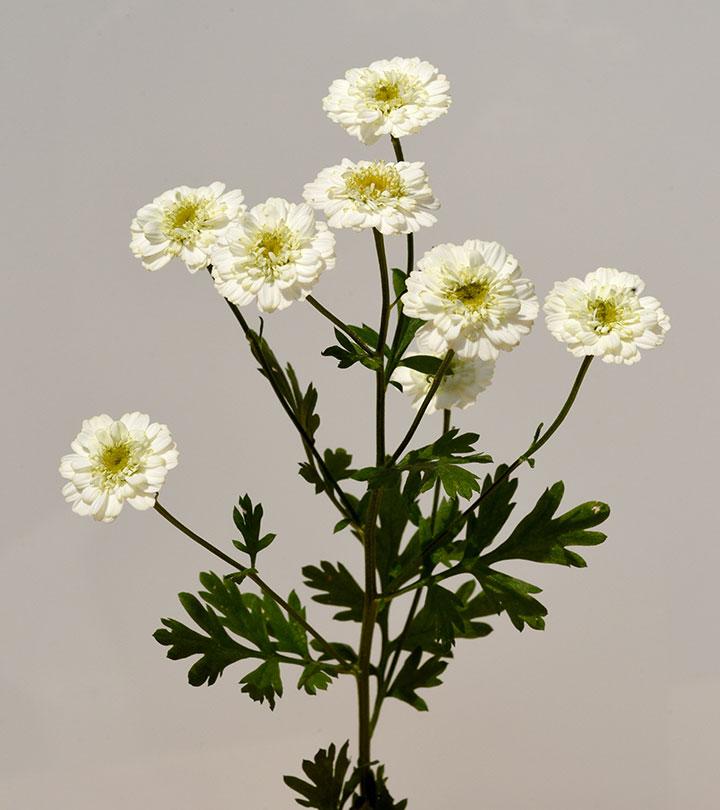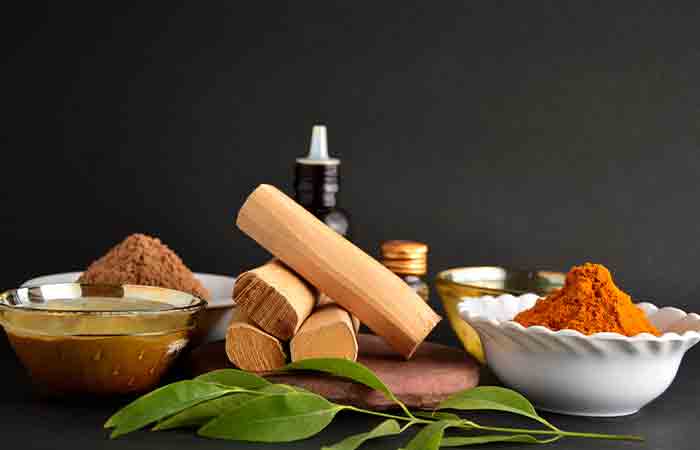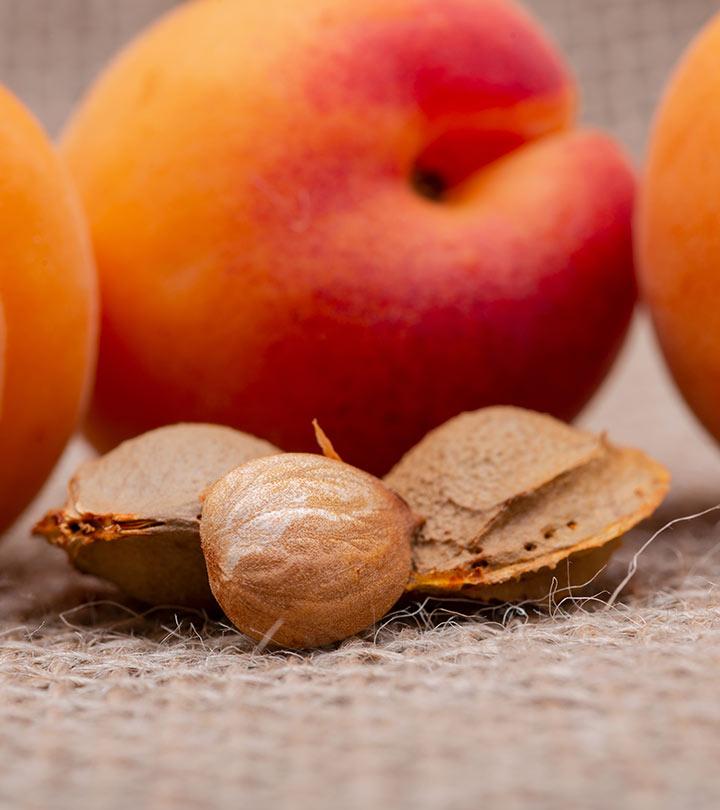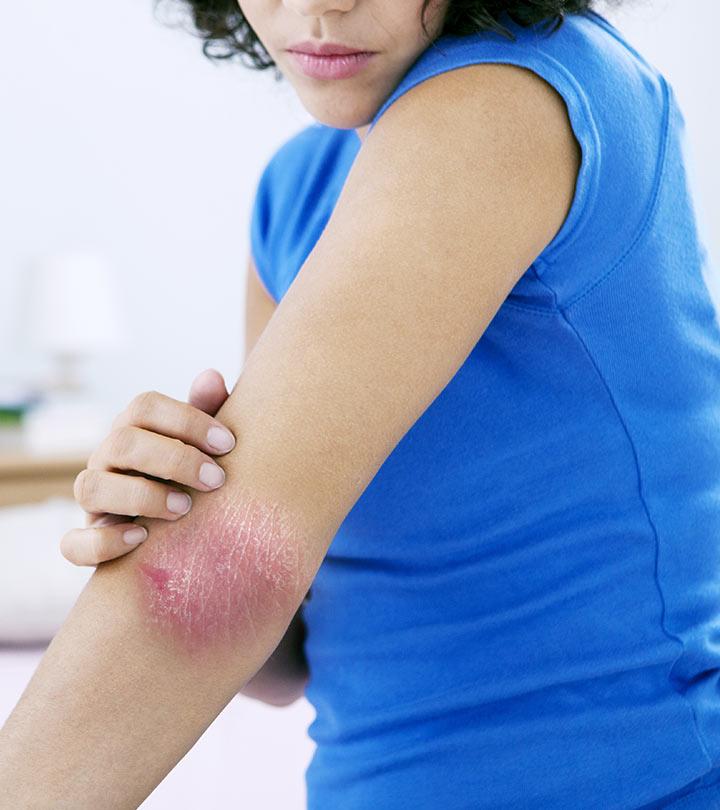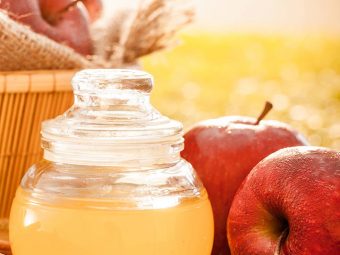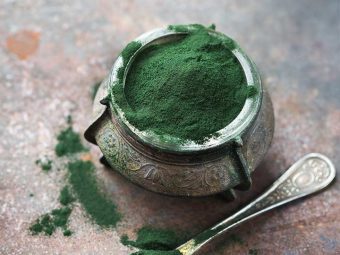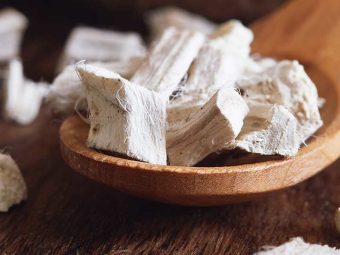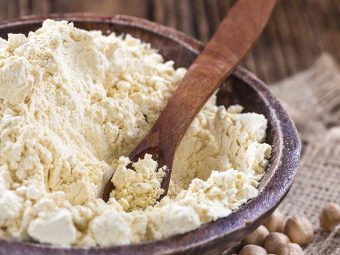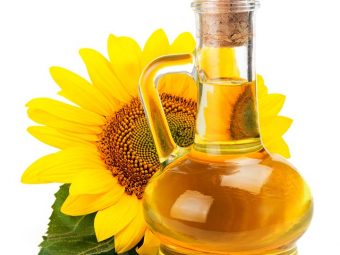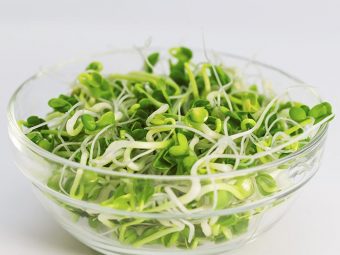8 Amazing Calendula Benefits And Possible Side Effects
From healing wounds to reducing pain, this medicinal herb benefits you in many ways.

Image: Shutterstock
Calendula flowers are not only aesthetic but also are valued medicinally. Calendula benefits you in multiple ways with its antibacterial, antiplaque, analgesic, and antiviral properties. They are also rich in antioxidants and exhibit the astringent effect. Many state that this flower is marigold’s doppelganger. Learn more about this flower and how it can be used to treat many chronic ailments. Continue reading.
 Know Your Ingredient: Calendula
Know Your Ingredient: CalendulaWhat Is It?
A flowering plant closely related to the marigold, with orange or yellow flowers.
What Are Its Benefits?
It possesses anti-HIV effects and may relieve menstrual discomfort, heal wounds and burns, and reduce inflammatory skin diseases and pain.
Who Can Use It?
People with sensitive skin can use or consume calendula to reduce any flare-ups and inflammation.
How Often?
For topical applications, 2-5% of calendula can be used 2-3 times daily. If consuming calendula powder, 1-2g per cup a day is recommended.
Caution
Avoid if you are on tranquilizers, pregnant, or allergic to other plants in the same family.
In This Article
What Is Calendula? What Is It Known For?
Calendula (Calendula officinalis) or pot marigold belongs to the Asteraceae family. It is closely related to field marigold, and its flowers share a close resemblance too (1).
The flowers and leaves of this plant have been used in traditional medicine. The medicinal properties of calendula have also been mentioned in Ayurvedic and Unani sciences. In 2008, the European Medicines Agency recognized it as an herbal medicinal product (2).
Folk medicine uses calendula leaves and flowers to treat wounds, rashes, bruises, stomach ulcers, edema, and several other inflammatory conditions. Its mother tincture is used in homeopathy to relieve mental tension and insomnia (1), (3).
 Fun Fact
Fun FactThe following sections will give you a detailed insight about calendula and its therapeutic benefits. Start scrolling!
What Are The Benefits Of Calendula?
Calendula is used to heal skin rashes, deep wounds, and ulcers. It is also said to work as a fever reducer and may help with microbial infections, menstrual irregularities, and varicose veins. Scroll down below to know more about the various calendula benefits and why they are good for your health.
1. Heals Wounds, Burns, And Scars
Calendula contains alkaloids, triterpenoids, flavonoids, and carotenoids. These phytochemicals trap the free radicals in your body and accelerate the process of healing of wounds and burns (thermal and sun). The plant controls the levels of compounds that promote inflammation, including nitric oxide and cytokines (4).
Animal studies were conducted to study the effects of oral and topical use of calendula extracts. The percentage of wound closure was about 90% in the group treated with the extract. Almost no skin toxicity was reported in any of the studies (4), (5).
Calendula ointment can also be used by women who have undergone C-section (Cesarean procedure). It considerably speeds up recovery and wound healing and can be used to support post-surgical care/treatment (6).
2. May Relieve Menstrual Discomfort
This flower was used to calm painful menstruation (dysmenorrhea) and menstrual irregularities in traditional and homeopathic medicine. Calendula oil, combined with other essential oils, is a common remedy (1), (7).
These oils prevent the transmission of nerve signals between the uterus and the brain. They also cause a transmission delay of the pain signal from the brain to the uterus.
Topical calendula lotions can help in controlling excessive menstrual bleeding and other related symptoms (7).
3. Treats Diaper Rashes
Diaper dermatitis or diaper rash is a common inflammatory reaction observed in infants, children, and adults wearing diapers. Painful skin eruptions occur in the areas covered by the diaper (8).
Not changing the diaper when needed and prolonged exposure to urine, feces, and moisture may cause this acute condition. Zinc deficiency and microbial infections may also lead to such rashes (8).
Generally, a mild cream/ointment or oral antibiotics can clear this allergy and soothe the skin. Medications based on calendula and aloe vera have also shown promising results. These herbs have anti-inflammatory and antimicrobial effects (8).
Moreover, no side effects of these herbal preparations have been reported so far (8).
4. May Help In Managing Inflammatory Skin Diseases
The tannins, triterpenoids, and saponins in calendula exert a deep-cleansing effect on your skin. When applied topically, its flower extracts may even heal acne and atopic dermatitis (eczema) (9), (10), (11).
Calendula also reduces radiodermatitis, which is skin damage caused by radiation. Radiodermatitis is one of the side effects of radiation therapy. Patients may develop redness (erythema) and skin toxicity (12).
Thanks to its antioxidant and astringent effects, this plant extract can reduce the levels of free radicals in your system. Using calendula cream/ointment with medical consent is a good option in such cases (9), (12).
However, in rare cases, calendula can induce contact dermatitis in these patients (13).
5. Maintains Dental Health
The antimicrobial and anti-inflammatory properties of this plant can be employed to treat dental issues as well. Periodontal diseasei XA severe gum infection brought by poor oral hygiene that can result in tooth loss and other major health issues. , gingivitisi XA type of gum disorder resulting in inflamed gums from bad dental hygiene. It can lead to tooth loss. , dental plaque, and other such inflammatory conditions turn chronic and painful in no time (14), (15).
You could use products with herbs like calendula, clove leaf, thyme, and eucalyptus to restore oral health and improve hygiene. These herbs can prevent the build-up of tartar and plaque on the teeth (14).
A mouthwash made of calendula extract significantly reduced gingivitis. Its active molecules could fight throat infections too. This plant extract can treat canker soresi XA painful, non-contagious, shallow sore that develops inside the mouth or at the gum line, brought on by stress, acidic foods, or injury. , aphthous ulcers (stomatitis), and sore throat (15).
Calendula has almost no side effects if orally consumed. It can be added as a component in candies, beverages, dental chew, toothpaste, lozenges, and whitening molds for better results (14).
6. Reduces Pain And Inflammation
Calendula inhibits the production of pain-inducing chemicals (prostaglandins) in your body. Animal studies show a 33% reduction in swelling/edema when treated with 250 mg/kg of its extract (16).
The plant prevents the release of histamines, which are chemicals known to cause redness, pain, allergies, and inflammation. The flavonoids, saponins, and triterpenoids in calendula are responsible for this property (17).
Different calendula formulations are used to treat women who underwent episiotomyi XA procedure to widen the aperture for the baby to exit by making an incision in the perineum and the posterior vaginal wall. during labor. Muscle spasms and injury can also be managed with them (16), (17).
Did You Know?
You can apply calendula ointment/lotion/tincture to heal hemorrhoidsi X A condition in which the rectum and anus veins are swollen and irritated, resulting in pain and bleeding. . It may even control the severity and pain in the affected areas to a certain extent (18).
Rosacea is another skin condition you can treat with calendula flower extracts. The phytochemicals clear the eruptions and redness of the skin (10). Calendula is added to hair care products as it may increase hair shine and smoothness.
The anti-inflammatory, cleansing/astringent, antioxidant, and pain-relieving properties of calendula are responsible for these effects (1).
Pot marigold flowers are colorful and vibrant. Their extracts are often used to color food products.
You can grow calendula at home too. All you need is good sunlight, ventilation, shade, a pot/patch of fertile soil, and moderate amounts of water. Once it germinates and establishes, calendula happily self-sows!
7. May Fight Cancer
Calendula can be a strong candidate for cancer treatment and palliative care in alternative medicine. Its phytochemicals have cytotoxic (cell-killing) effects on human cancer cells (3), (19).
The roots and flower extracts have shown positive effects on skin cancer (melanoma), breast cancer, and leukemia cells. The active molecules have been identified to be polysaccharides, proteins, fatty acids, carotenoids, flavonoids, triterpenoids, and saponins (3), (20).
These molecules inhibit the cell division in cancer cells to prevent metastasis (spreading). Calendula also induces programmed cell death (apoptosis) in these cells to ensure 100% growth inhibition (20).
8. Exhibits Anti-HIV Effects
This flower extract has antiviral properties. Researchers have recognized/identified anti-HIV (Human Immunodeficiency Virus) activity, in particular. In a study, about 90% of the target cells were protected from HIV infection in the presence of 10-30 mcg/mL of calendula flower extract (21)
The flavonols in the flowers block the initial-stage interactions between viruses and cells. The extract inactivates several HIV proteins, even when present in small concentrations (21).
Calendula prevents the activity of a crucial viral protein called reverse transcriptase (RT). The RT enzyme allows HIV to survive in human host cells, thereby causing AIDS (21).
Further research would help isolate the principal molecules behind this property (21).
 Quick Tip
Quick TipLab experiments and chemical analyses have revealed a unique biochemical profile of this plant. We will explore that in the following section.
Phytochemical Composition Of Calendula
Calendula officinalis contains high amounts of triterpenes, flavonoids, carotenoids, phenolic acids, fatty acids, sterols, tannins, quinones, and carbohydrates (1), (22).
| Triterpenes glycosides/Monoterpenes/conjugated terpenes | Calendulaglycoside A, B, CD, F, G. Esters like taraxasterol, faradiol, heliantriol, arnidiol, lupeol, calenduladiol, ursadiol, brein, amyrin, maniladiol, erythrodiol; limonene, cineol |
| Flavonoids | Quercetin, kaempferol, isorhamnetin, rutin, astragalin, isoquercitrin |
| Carotenoids | Lutein, zeaxanthin, flavoxanthin, auroxanthin, ß-carotene, luteoxnathin, violaxanthin, ß-cryptoxanthin, mutaxanthin |
| Phenolic acids/Fatty acids | Chlorogenic acid, caffeic acid, coumaric acid, vanillic acid, linoleic acid, calendic acid |
| Quinones | 𝛼-tocopherol, phylloquinone |
| Volatile oils | 𝛼-copaene, 𝛼-ionone, 𝛼-humulene, geranylacetone, β-ionone, ledene, 𝛼-murolene, 𝛼-cadinene, 𝛼-calacorene, viridiflorol, ledol, limonene, 𝛼-cadinol and cadalene |
These phytochemicals enhance the therapeutic value of calendula flower heads. Using them in the right way and amount will put the molecules to action.
 Trivia
TriviaIs there a recommended way of using calendula? Scroll down to know.
How Much Of Calendula Is Safe?
A recommended dose for calendula has not been framed yet.
However, a 2%-5% calendula ointment can be applied topically to heal wounds. If using a tincture (1:9 in 20% alcohol), 2-4 ml per ¼-½ cup of water can be taken three times a day (22).
Another option could be using 1-2 g of Calendula powder per cup of water (22).
Depending on the condition/ailment, this herbal medicine can be taken in different/multiple ways. The most suitable dose and mode of administration have to be decided by your healthcare provider.
Avoid self-medication.
Calendula may induce acute adverse effects in certain individuals. Find more on this in the next section.
Does Calendula Have Any Side Effects Or Risks?
If you are allergic to plants from the Asteraceae family, calendula may trigger a cross-reaction/hypersensitivity in your body. Keep your doctor informed of such symptoms (22).
There is a >1% chance of developing contact dermatitis if you have frequent skin contact with this herbal preparation (22).
Also, you may be advised against using calendula products if you are on tranquilizers (23).
No herb-drug interactions have been reported with this plant yet (24).
The safety of calendula products in pregnant and lactating women is not clear yet. There is insufficient data to establish dosage in these cases (24).
The benefits of calendula go beyond its aesthetic appeal. It is packed with many beneficial phytonutrients such as flavonoids, carotenoids, fatty acids, and volatile oils. This rich nutritional profile may account for its use in some traditional remedies. It may be beneficial for treating burns, wounds, and rashes, easing menstrual cramps pain, and may help in cancer prevention. It is antispasmodic and helps reduce inflammation too. Additionally, it may improve eye health as it can soothe eye inflammations (25). Calendula has antitumor, antiviral, and antibacterial properties as well. However, excessive use may trigger allergic reactions. If you experience any adverse effects, stop its use and consult your healthcare provider.
Frequently Asked Questions
What type of skin is calendula good for?
Calendula is well tolerated by all skin types.
How do you use calendula for healing?
Calendula can be applied externally to heal wounds or ingested to heal problems associated with the digestive issues or the mouth. It has a detoxifying effect that may flush out the toxins.
Can calendula brighten skin?
Calendula is used in skin care to brighten the skin and restore its elasticity, thus exhibiting its anti-aging effects.
Key Takeaways
- Ayurveda, Unani, and homeopathy mention the medicinal benefits of Calendula.
- It is rich in alkaloids and antioxidants, thus possessing potential wound-healing properties.
- It can provide relief from menstrual discomfort and control bleeding.
- Calendula is safe for oral consumption; hence, you can use it to manage dental issues. Calendula mouthwash can treat sores and ulcers.
- Studies point to its efficiency in fighting HIV and cancer under laboratory conditions. Further research is ongoing to establish these qualities.
A natural remedy like calendula can help soothe skin, reduce inflammation, and promote healing. Check out the video below to know more about how effective it is against skin rashes and surgical sutures.
Sources
- A review on phytochemistry and ethnopharmacological aspects of genus Calendula, Pharmacognosy Review, US National Library of Medicine, National Institutes of Health.
https://www.ncbi.nlm.nih.gov/pmc/articles/PMC3841996/ - Growing & using calendula, UC Master Gardeners of San Mater & San Francisco, University of California Agriculture and Natural Resources, Reagents of the University of California.
http://smsf-mastergardeners.ucanr.edu/Elkus/Growing_and_using_calendula/Cale - ndula officinalis: Potential Roles in Cancer Treatment and Palliative Care, Integrative Cancer Therapies, US National Library of Medicine, National Institutes of Health.
https://www.ncbi.nlm.nih.gov/pmc/articles/PMC6247547/ - Effect of Calendula officinalis Flower Extract on Acute Phase Proteins, Antioxidant Defense Mechanism and Granuloma Formation During Thermal Burns, Journal of Clinical Biochemistry and Nutrition, CiteSeerX, The Pennsylvania State University.
http://citeseerx.ist.psu.edu/viewdoc/download?doi=10.1.1.275.4533&rep=rep1&type=pdf - Wound healing activity of flower extract of Calendula officinalis. Journal of Basic and Clinical Physiology and Pharmacology, US National Library of Medicine, National Institutes of Health.
https://www.ncbi.nlm.nih.gov/pubmed/19601397 - The impact of calendula ointment on cesarean wound healing: A randomized controlled clinical trial, Journal of Family Medicine and Primary Care, US National Library of Medicine, National Institutes of Health.
https://www.ncbi.nlm.nih.gov/pmc/articles/PMC6259546/ - Effect of Medicinal Herbs on Primary Dysmenorrhoea- a Systematic Review, Iranian Journal of Pharmaceutical Research, US National Library of Medicine, National Institutes of Health.
https://www.ncbi.nlm.nih.gov/pmc/articles/PMC4177637/A - Randomized Comparative Trial on the Therapeutic Efficacy of Topical Aloe vera and Calendula officinalis on Diaper Dermatitis in Children, The Scientific World Journal, US National Library of Medicine, National Institutes of Health.
https://www.ncbi.nlm.nih.gov/pmc/articles/PMC3346674/ - Medicinal Plants for the Treatment of Acne Vulgaris: A Review of Recent Evidences, Jundishapur Journal of Microbiology, US National Library of Medicine, National Institutes of Health.
https://www.ncbi.nlm.nih.gov/pmc/articles/PMC4740760/ - Medicinal Plants used as Anti-Acne Agents by Tribal and Non-Tribal People of Tripura, India, American Journal of Phytomedicine and Clinical Therapeutics, CiteSeerX, The Pennsylvania State University.
http://citeseerx.ist.psu.edu/viewdoc/download?doi=10.1.1.677.6077&rep=rep1&type=pdf - Medicinal plants used in treatment of inflammatory skin diseases, Advances in Dermatology and Allergology, US National Library of Medicine, National Institutes of Health.
https://www.ncbi.nlm.nih.gov/pmc/articles/PMC3834722/ - A Review of the Use of Topical Calendula in the Prevention and Treatment of Radiotherapy-Induced Skin Reactions, Antioxidants, US National Library of Medicine, National Institutes of Health.
https://www.ncbi.nlm.nih.gov/pmc/articles/PMC4665477/ - WHOLE HEALTH: CHANGE THE CONVERSATION, Skin Health Educational Overview, VHA Office of Patient Centered Care and Cultural Transformation, Whole Health Library, University of Wisconsin-Madison.
http://projects.hsl.wisc.edu/SERVICE/modules/24/M24_EO_Skin_Health.pdf - Herbal Remedies for the Treatment of Periodontal Disease – A Patent Review, Recent Patents on Drug Delivery & Formulation, Bentham Science Publishers Ltd., Academia.
https://www.academia.edu/11906993/Herbal_remedies_for_the_treatment_of_periodontal_disease–a_patent_review - Evaluation of Calendula officinalis as an anti-plaque and anti-gingivitis agent, Journal of Indian Society of Periodontology, US National Library of Medicine, National Institutes of Health.
https://www.ncbi.nlm.nih.gov/pmc/articles/PMC3917203/ - Anti-inflammatory activity of flower extract of Calendula officinalis Linn. and its possible mechanism of action. Indian Journal of Experimental Biology, US National Library of Medicine, National Institutes of Health.
https://www.ncbi.nlm.nih.gov/pubmed/19374166 - The Impact of Aloe vera and Calendula on Perineal Healing after Episiotomy in Primiparous Women: A Randomized Clinical Trial, Journal of Caring Sciences, Tabriz University of Medical Sciences, Academia.
https://www.academia.edu/32925434/The_Impact_of_Aloe_vera_and_Calendula_on_Perineal_Healing_after_Episiotomy_in_Primiparous_Women_A_Randomized_Clinical_Trial - Botanical Treatments for Hemorrhoids, Alternative & Complementary Therapies, Academia.
https://www.academia.edu/2936982/Botanical_Treatments_for_Hemorrhoids - Radiation Therapy: Caring For Your Skin Non-Prescription, Comprehensive Cancer Center, University of Michigan Health System.
http://www.cancer.med.umich.edu/files/radiation-therapy-caring-for-your-skin-non-prescription.pdf - A new extract of the plant calendula officinalis produces a dual in vitro effect: cytotoxic anti-tumor activity and lymphocyte activation, BMC Cancer, US National Library of Medicine, National Institutes of Health.
https://www.ncbi.nlm.nih.gov/pmc/articles/PMC1513589/ - Anti-HIV activity of extracts from Calendula officinalis flowers, Biomedicine and Pharmacotherapy, Elsevier, Academia.
https://www.academia.edu/8123660/Anti-HIV_activity_of_extracts_from_Calendula_officinalis_flowers - THE CHEMICAL CONSTITUENTS AND PHARMACOLOGICAL EFFECTS OF CALENDULA OFFICINALIS- A REVIEW, Indian Journal of Pharmaceutical Science & Research, Academia.
https://www.academia.edu/32198418/THE_CHEMICAL_CONSTITUENTS_AND_PHARMACOLOGICAL_EFFECTS_OF_CALENDULA_OFFICINALIS_-A_REVIEW - Pot marigold (Calendula officinalis) medicinal usage and cultivation, Scientific Research and Essays, CiteSeerX, The Pennsylvania State University.
http://citeseerx.ist.psu.edu/viewdoc/download?doi=10.1.1.1011.8118&rep=rep1&type=pdf - Marigold (Calendula officinalis L.):An Evidence-Based Systematic Review by the Natural Standard Research Collaboration, Natural Standard Review, Journal Of Herbal Pharmacotherapy, Academia.
https://www.academia.edu/16805254/Marigold_Calendula_officinalis_L._an_evidencebased_systematic_review_by_the_Natural_Standard_Research_Collaboration



